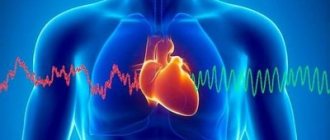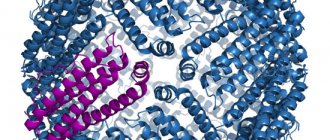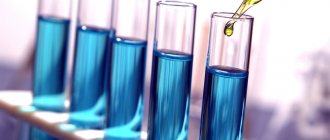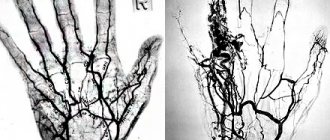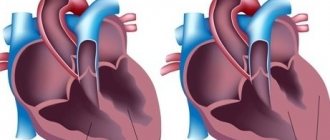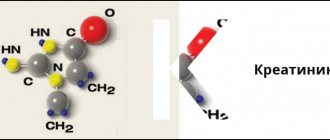In what rare situations can the study of AT-TPO and AT-TG be indicated in case of normal thyroid function?
- When, during pregnancy, the level of TSH (thyroid-stimulating hormone) exceeds trimester-specific norms,
- When planning an in vitro fertilization procedure,
- Before prescribing amiodarone, interferon and lithium drugs (since antibody carriers have an increased risk of developing thyroid pathology induced by these drugs)
- To assess the effectiveness of treatment for differentiated thyroid cancer, monitoring of AT-TG levels may be necessary.
Studying the levels of AT-TPO and AT-TG in other situations can be considered redundant, and the interpretation of the results is meaningless.
Marina Aleksandrovna Sviridonova , endocrinologist
, Ph.D.
Thyroglobulin is elevated - why? What is the normal thyroglobulin level?
Thyroglobulin is normally located in the lumen of the follicles and enters the blood only in minimal quantities. Its increased “leakage” into the blood is observed when thyroid tissue is destroyed due to various influences:
- autoimmune inflammation in Hashimoto's thyroiditis, diffuse toxic goiter, subacute thyroiditis;
- purulent inflammation with purulent thyroiditis;
- destruction of thyroid tissue in the patient’s body after radioactive iodine therapy;
- destruction of thyroid nodule tissue after ethanol sclerotherapy, radiofrequency ablation, laser destruction, or even after fine-needle biopsy of the nodule;
- destruction of gland tissue after diagnostic scintigraphy of the gland using iodine-131, which, in addition to diagnostic gamma radiation, also has beta radiation that destroys thyroid tissue;
- death of residual thyroid cells after thyroidectomy or partial resection of gland tissue (after any surgery on the gland).
«Thyroglobulin normal
“,” “
increased thyroglobulin
,” “
what to do; increased thyroglobulin
” - these queries are regularly found in search engines such as Yandex or Google. The wording of the search query itself already indicates that most patients do not understand what thyroglobulin is and in what cases its level can be used in diagnosis.
It is important to understand that in patients with a preserved thyroid gland, the level of thyroglobulin should not be determined at all. An analysis for thyroglobulin in the presence of a thyroid gland will only show how large the gland is, how well or poorly it works, and whether there is an inflammatory process in the tissue or not. Indeed, the level of thyroglobulin in the blood depends only on:
- the volume of the thyroid gland and the size of the nodes present in it;
- activity of hormone production;
- the presence or absence of inflammatory processes in the gland tissue.
The larger the volume of the thyroid gland, the more it produces thyroglobulin - this is logical. The more active the thyroid gland is, the more hormones it releases into the blood, the more thyroglobulin is required - this is also logical. The more active the process of inflammation occurs in the gland tissue, the more actively the cells themselves and the follicles formed by the cells are destroyed, and the more actively thyroglobulin leaks into the blood - and this is also quite logical.
At the same time, if a non-specialist turns to Internet materials, the first thing he will glean from them is information that thyroglobulin is a tumor marker, that its level indicates the risk of thyroid cancer. As a result, many patients experience stress, which is usually not based on anything, and which does nothing but cause unnecessary harm.
It is important to understand one feature: yes, this is a tumor marker, yes, its level increases in patients with recurrent papillary or follicular thyroid cancer, but this dependence “increased thyroglobulin = relapse of thyroid cancer” occurs only in those patients WHO HAVE PREVIOUSLY REMOVED THE THYROID GLAND .
Think about it, this is also quite logical - if we know that thyroglobulin in the human body is produced only by the cells of the thyroid gland, as well as by the cells of two malignant tumors of the thyroid gland (papillary and follicular cancer), then we must understand that after complete removal of the gland and complete After removing the tumor, there should be no places left where thyroglobulin can be produced, and therefore its level should become very low, close to zero.
However, this relationship is only valid if the thyroid gland and tumor are first removed. If the patient’s thyroid gland is in its usual place, if no operations have been performed, then the blood test for thyroglobulin itself loses all meaning. Even if you and I see that thyroglobulin is elevated, what will we do? What medical recommendations can an endocrinologist give to a patient in this case? Absolutely none. The level of thyroglobulin in the blood, whether it is elevated or not, with a preserved thyroid gland is not the basis for determining treatment tactics, therefore this test should not be taken - this would be a pure waste of the patient’s funds.
Currently, specialists at the North-Western Endocrinology Center very often have to meet with patients from various regions of Russia who come to us for expert consultation with one question: “What to do - increased thyroglobulin?” It is very sad to see how people come from distant cities - Krasnodar, Murmansk, Magadan, only to find out that their analysis does not indicate any diseases, and that they are generally completely healthy. Of course, it happens that our endocrinologists identify various diseases of the thyroid gland in patients who come to us, it even happens that we perform some kind of surgery on the thyroid gland, but blood thyroglobulin is never an indication for treatment or a diagnostic criterion in such cases. .
Why do doctors prescribe thyroglobulin testing to patients across the country? Don’t endocrinologists themselves understand that this indicator is diagnostically unreliable? There are only two possible explanations for the fact that this analysis is widely used: either the doctor himself does not really understand the meaning of this indicator, or he understands this meaning (or rather, understands that there is no special meaning), but prescribes it simply to increase the patient’s expenses.
Thyroid-stimulating hormone (TSH, thyrotropin)
A glycoprotein hormone that stimulates the formation and secretion of thyroid hormones (T3, T4).
They enter the body with food and are also synthesized by cells of adipose tissue, liver, and intestines. They do not circulate freely, but are bound to proteins and transported in the form of macromolecular complexes - lipoproteins. They are the main lipids of fatty deposits and food products. The triglyceride molecule contains triatomic glycerol and 3 residues of higher fatty acids, mainly palmitic, stearic, linoleic and oleic.
It is produced by basophils of the anterior pituitary gland under the control of thyroid-stimulating hypothalamic releasing factor, as well as somatostatin, biogenic amines and thyroid hormones. Increases vascularization of the thyroid gland. Increases the supply of iodine from blood plasma to thyroid cells, stimulates the synthesis of thyroglobulin and the release of T3 and T4 from it, and also directly stimulates the synthesis of these hormones. Enhances lipolysis.
There is an inverse logarithmic relationship between the concentrations of free T4 and TSH in the blood.
TSH is characterized by daily fluctuations in secretion: blood TSH reaches its highest values at 2 - 4 am, the highest level in the blood is also determined at 6 - 8 am, the minimum TSH values occur at 17 - 18 pm. The normal rhythm of secretion is disrupted when awake at night. During pregnancy, the concentration of the hormone increases. With age, the concentration of TSH increases slightly, and the amount of hormone emissions at night decreases.
Limits of determination:
0.0025 mU/l - 100 mU/l.
General indicators, decoding
A complete picture of the state of the body and hormonal levels can be obtained by passing one of the following types of tests:
Thyroid hormones:
- Free T4 is one of the most important biologically active substances of the thyroid gland, which is responsible for transporting protein compounds and maintaining their optimal balance in the body. The normal plasma level for a healthy person is from 10 to 22 mmol/l. An excess indicates somatic or mental illnesses, lipemia. Deficiency - about pregnancy, poor nutrition, heavy physical activity, use of a number of medications.
- TSH – directly affects the thyroid gland and is responsible for the circulation of its components. The norm for an absolutely healthy person is from 0.4 to 4 mU/liter. An excess indicates adrenal insufficiency, complex non-thyroid pathology, etc. Low level – about thyrotoxicosis, cortisol imbalance, etc.
- T3 general - needed to stabilize the peripheral endocrine glands. The norm is 1.3 – 2.7 nmol/l. An excess of the hormone indicates pregnancy, taking drugs or estrogen. Disadvantage - about gastrointestinal pathology, acromegaly, hemolysis, starvation and other disorders.
- Total T4 is one of the main bioactive substances of the thyroid gland. Correct values are from 59 to 160 nmol/l. Going beyond these numbers to a greater extent can indicate obesity, the presence of hepatitis, pregnancy, etc., to a lesser extent - about starvation, excessive physical activity, kidney and gastrointestinal diseases.
- Free T3 – stimulates oxygen circulation in soft tissues. The normal range is from 2.6 to 5.6 pmol per liter. Exceeding the indicators indicates hyperthyroidism, toxicosis, a deficiency indicates peripheral vascular resistance syndrome, taking iodine-containing medications.
- Antithyroglobulin antibodies (AT-TG) help identify some autoimmune diseases. The normal value ranges from 0 to 4.11 U/ml.
- TSH is one of the main functional elements of the thyroid gland. The norm for a healthy person ranges from 258 to 574 nmol/liter. A higher reading may indicate pregnancy, hepatitis or hypoproteinemia.
Sex hormones:
- Estradiol is an active component in the blood of women, which is responsible for the maturation of germ cells and affects the proper development of the fetus during pregnancy. The norm varies depending on the life cycle: from 200 to 286 pm/l (for women in the follicular phase), from 52 to 136 pm/l (for women during menopause) and from 441 to 576 (girls in the luteal phase). An excess indicates possible tumors on the ovaries, a deficiency indicates a failure in the release of gonadotropic hormones.
- Testosterone - directly affects the growth of muscle mass, strengthening bones, and the formation of sexual characteristics. Indicators range from 2 to 10 ng/ml in men and from 0.2 to 1 in women
- Progesterone appears in the body after the formation of the egg. The pregnancy hormone, as it is also called, is responsible for the stability of the development of the intrauterine fetus. The norm is from 22 to 30 nm/l in the luteal phase, 1 – 2.3 nm/l in the follicular phase, 1 – 1.8 during menopause. If the value is higher than normal, then this may indicate pathological processes in the adrenal cortex, if less, it may indicate ovarian sclerosis.
Pituitary hormones:
- ACTH is responsible for the release of bioactive substances in the adrenal cortex. Correct values are up to 50 pg/ml. If more, hyperplasia is possible, less - adrenal insufficiency, tumor.
- Prolactin is responsible for stimulating lactation in women and the functioning of the prostate in representatives of the stronger half. For the latter, the norm is from 100 to 266 µg/l, for women of childbearing age from 129 to 539 µg/l, for women in menopause – from 106 to 289 µg/l.
- Growth hormone is responsible for the development of bone and muscle mass and other important organs. The norm is up to 10 ng/ml. Elevated levels indicate acromegaly or gigantism, while low values indicate pituitary dwarfism.
- LH – ensures the complete maturation of the egg in women and sperm in men. The norm for guys is from 2.12 to 4 mIU/ml, for girls, depending on the menstrual cycle, from 1.55 to 53 mIU/ml. Deviation in one direction or another is a sign of various dysfunctions of the gonads.
Adrenal hormones:
- Adrenaline and norepinephrine are responsible for the rhythm of the heart muscle, pressure, blood vessels, motility, and form glucose levels. Correct values are from 1.9 to 2.45 nm/l and from 0.6 to 3.22, respectively. An excess indicates jaundice, renal pathologies, a deficiency indicates myasthenia gravis or damage to the hypothalamus.
- Cortisol – responsible for susceptibility to allergic reactions, systematizes the production of antibodies. The norm is from 229 to 749 nm/l. If the readings are lower, there is a possibility of Addison's disease or adrenal disease; exceeding the norm indicates an adenoma or cancer.
- Aldosterone is an important hormone responsible for the balance of water and salt. The correct value ranges from 30 to 172 pg/ml. Deficiency is a sign of thrombosis, poor nutrition, arterial embolism. An excess may indicate a tumor in the adrenal glands or hyperplasia.
Description
Extensive laboratory testing of thyroid function.
The thyroid gland is one of the most important organs of the human endocrine system. The main function of the thyroid gland is to produce thyroid hormones. They regulate most metabolic processes in the body.
Why is it important to have your thyroid examined?
The thyroid gland affects the entire body as a whole, and even the most insignificant, at first glance, deviations from the norm have an impact on the body’s metabolism, cardiac, nervous and reproductive systems. The earlier a thyroid pathology is detected, the easier it is to treat.
Why is it better to undergo a comprehensive examination?
The thyroid gland synthesizes 2 main hormones: T3 and T4, the formation of which is regulated by TSH (synthesized in the pituitary gland), it is important to see the whole picture. In addition, TG and TPO are involved in the formation of hormones in the thyroid gland, to which, in some forms of pathology, antibodies are formed in the thyroid gland, therefore, to assess the function of the thyroid gland, a comprehensive examination is necessary. The value of laboratory tests increases with simultaneous ultrasound examination (US).
Symptoms of thyroid dysfunction (in children and adults):
- Sudden weight changes.
- Unstable menstrual cycle in women and teenage girls.
- Change in appearance: problems with skin, hair, nails.
- Disorders of the gastrointestinal tract and cardiovascular systems
- Memory deterioration, slow thinking and speech.
- Increased sweating, hand tremors and increased body temperature.
- Weakness, irritability, tearfulness.
- Decreased immunity, tendency to colds.
Who should have a thyroid examination?
Everyone without exception: women and men, children.
For the purpose of prevention and if one or more of the above symptoms appear, it is recommended to undergo a comprehensive examination of the thyroid gland: take tests, undergo an ultrasound and, based on the results of the examination, consult a doctor.
Rules for donating blood for thyroglobulin
When donating blood after treatment for cancer testing, it is important to know a few rules:
- a blood test for thyroglobulin becomes reliable 3 months after surgical treatment and 6 months after radioactive iodine therapy
; If you take the test early, you may see a false increase in the indicator and think that your cancer is developing a recurrence; - always, together with thyroglobulin, a test for antibodies to thyroglobulin is taken
; an increase in antibodies in the patient’s blood completely eliminates the diagnostic value of the thyroglobulin test - with high antibodies, it will always be at low values, since antibody molecules will bind protein molecules and “mask” them from the analyzer; - a blood test for thyroglobulin, taken while taking thyroxine and against the background of a low level of the hormone TSH in the blood, has diagnostic value
and can detect a relapse of thyroid cancer, but in 20-25% of cases, relapses of thyroid cancer will not lead to an increase in thyroglobulin if the TSH level low - in such cases, only the abolition of thyroxine for 3 weeks followed by an increase in the TSH level will be able to identify existing tumor metastases based on the fact that thyroglobulin will become high; and still, the so-called unstimulated thyroglobulin (i.e., a blood test for thyroglobulin taken while taking thyroxine) has diagnostic value and should be used in clinical practice - a blood test for thyroglobulin, taken after stopping thyroxine for 3 weeks, is the most accurate indicator of tumor relapse
(a prerequisite for using this test in practice is the absence of elevated antibodies to thyroglobulin in the blood); - in many cases, what is more important is not the level of thyroglobulin in the blood, but the dynamics of its change
(i.e. if it is moderately elevated, but falls over time, this is much better than if it was lower at the beginning, but then began to increase).

